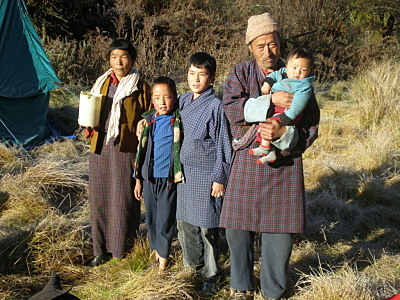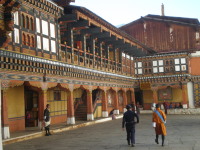
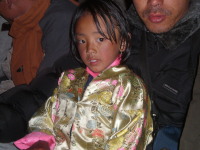
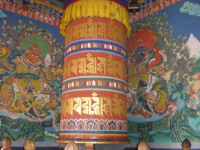
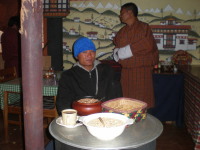
Cycle LEJOG
New Zealand S
New Zealand N
Vanuatu - Tanna
Vanuatu - Efate
India - Kolkata
India - Andaman
Bhutan
After a week in Kolkata, Bhutan can only be described as genteel – a great relief.
When you first enter Bhutan, the most striking difference is colour. It is everywhere, from peoples' dresses to the outside of buildings.
Being in Bhutan is like entering a time warp. For the past 100 years the country has been ruled by the King. The present King has followed a modernisation policy but previous Kings had an isolation policy. The stated aim of the present King is that the happiness of his subjects is more important than the country’s wealth. However all could be changing shortly. In 2008, Bhutan has changed into a democracy, with elections occurring in April.
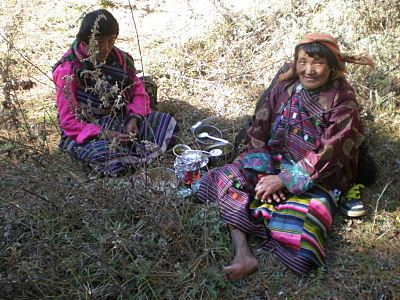
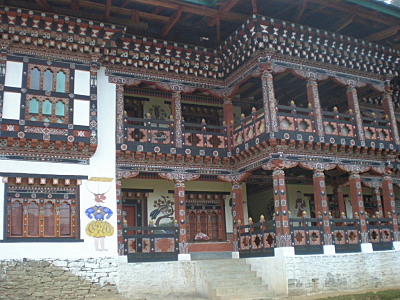
Above - Two travellers we met on a path through the mountains. Note the cannabis growing on the left. The house depicts the typical Bhutan style.
If you have come across Bhutan, it has probably been via a TV program from Michael Palin or Bruce from ‘Tribe’. Outside these two fairly recent programs, there is very little coverage of Bhutan in the West. The country has only allowed tourists to enter since 1974, with the number slowly increasing since then. Last year the total was around 15,000 tourists, which is a small number for 52 weeks spread across a country the size of Switzerland.
Bhutan has a policy of high value low impact tourism. This has been achieved by charging every tourist $200 (approx £100) per day. This $200 will cover all accommodation, food, travel and the services of a full time guide and driver. When choosing a tour company, as the price is always the same, the only choice is what you get for your $200. We choose Yu-druk tours, which proved wise. Our ‘tour’ was just for the two of us so the group consisted of the driver, guide and us. You have to visit Bhutan as a guided tour. Independent travel is not allowed. The guide is responsible for ensuring that you do not go into areas “not suitable for tourists” – whatever this means
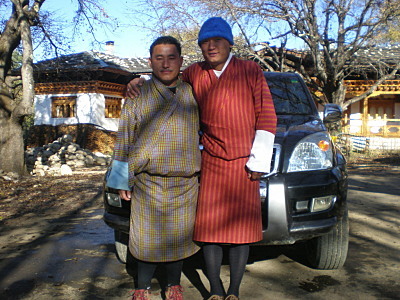
Above - Guide and Driver
To understand Bhutan, you first have to understand Buddhism, or at least the symbolism of Buddhism. Herein lies our first problem with comprehending this place. Everywhere one goes there are reminders of Buddhism, from the monastery in every town or village, the stupas (shrines) in the middle of roads or at important junctions, spinning prayer wheels and flags fluttering everywhere, the artwork painted inside and outside of most houses, to monks walking down the street. Supposedly, no animal is killed in Bhutan, yet most meals contain meat imported from India – strange. This no killing policy also extends to sick animals. In the last outbreak of rabies, the rabid animals were rounded up and put into a compound until they died naturally. We saw a number of very sick dogs roaming the streets.
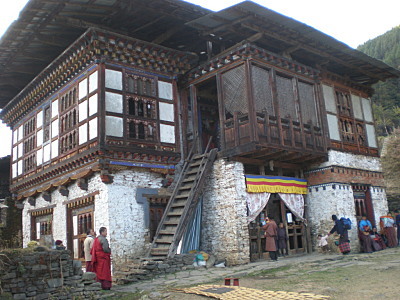
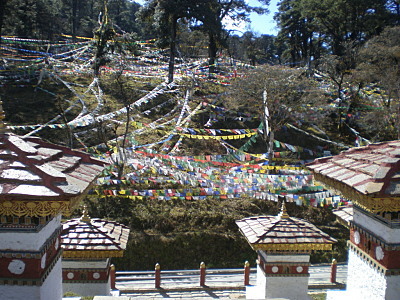
Walk through any village or town and you will see monks. 5% of the population are monks, or 10% of men. In the West one assumes that people choose a life of devotion but this is not usually the case here. Many are put into the monastery at around 4 years old by their parents, either as homage to Buddhism, or because their parent cannot afford to feed and clothe them. The young monk children are like any other children we have seen. Note the paper aeroplane in the young monk’s hand, being used during a lesson. To escape monastic life, you have to pay a release fee of 10,000 Nu (approx £120, $240) a considerable fee for most monks. Some leave in their 20s. If they are still there at 30, they are usually monks for life. Our own guide was put into a monastery aged 4. He ran away but was caught and beaten by the monks. The second time he was successful, but his parents still had to pay the 10,000 Nu release fee.
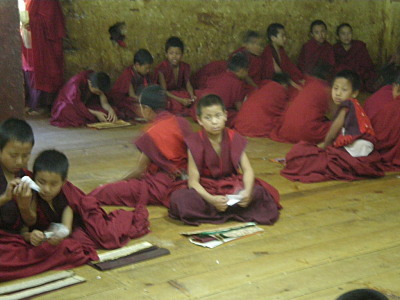
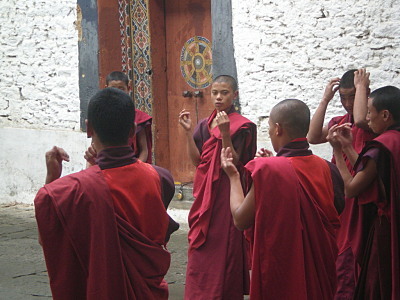
People seem to practice Bhudism, not through contemplation as we had thought but through ritual actions. Spinning a prayer wheel sends blessings to all as does walking or driving (always clockwise) around a stupa or temple. Magic is fundamental to most people’s belief, with many villagers avoiding certain paths because of ghosts. Sometimes you don’t even have to spin a prayer wheel by hand because they are water driven in the same way as a water mill.


Above - large prayer wheel at a monastary and right, a water driver prayer wheel in the building with a carving and painting behind.
Festivals are also an expression of Bhudism. They are frequent and are usually held in a fortress or monastery. They last for several days and feature masked and costumed dances by monks and villagers. These dances usually tell a historical story with a religious theme and are used to ward away evil, give thanks and invoke blessings with a lot of horseplay thrown in.
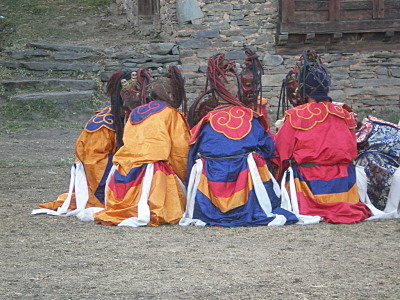

Above - Bumthang festival in November / December
Another important aspect of a festival is Arra. This liquor is home distilled from wheat or rice and arrives with every villager in assorted containers, from plastic fizzy drink bottles to engine oil containers. It is liberally handed round. To refuse is very rude and to avoid a top up, near impossible.
The men below (left) are heading for the house of the head man in the village to share a jug of Arra. The village women (below right) invited us to share their Arra (note the containers) in exchange for a small donation (about 80p - £1). This was their way of making money.
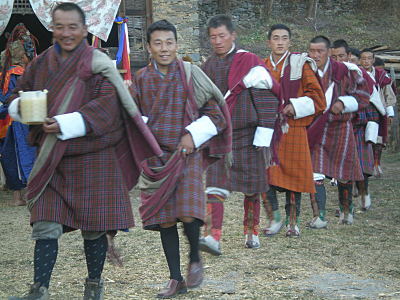
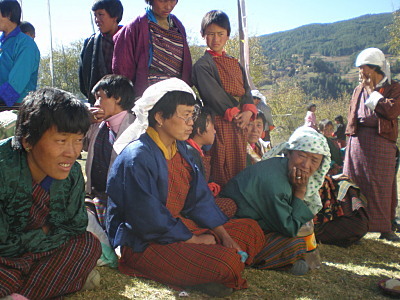
Bhutan has 13 designated arts and crafts. They are a vital part of Bhutanese life and feature everywhere. They have an almost entirely religious theme and are anonymous.
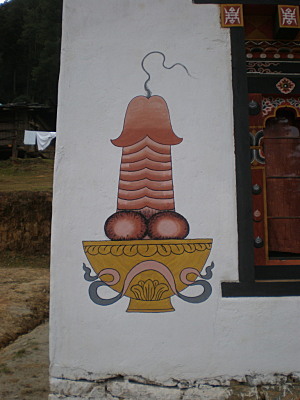
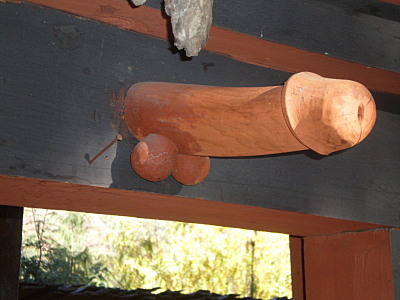
The above promote fertility and strength and are very popular symbols.
The school of Arts and Crafts in Thimphu gives a six year apprenticeship to adolescents in one chosen discipline such as painting, pottery (mask or icon making) weaving, sewing or wood carving. A painting student may spend weeks perfecting a copied drawing of a dragon, a Buddha or an auspicious symbol following precise rules of form. No artistic licence is allowed. All painting students learn a set repertoire of religious images hoping for employment painting murals on houses or temples.
The purpose of art is public service rather than self expression.
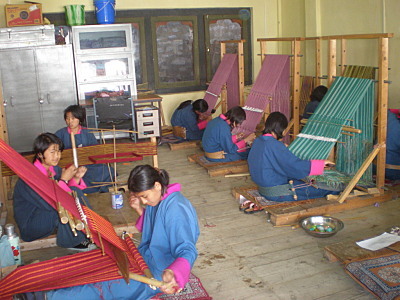
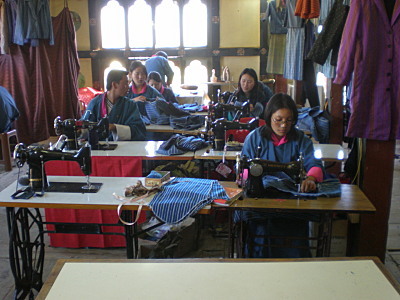
Afternoons are for practice so no teachers were present. The girls were busy but the boys were more taken with their mobile phones which quickly disappeared into pockets when we arrived.
Houses in Bhutan are interesting. They are usually wooden with large overhanging roofs. Typically the animals live on the ground floor. Upstairs is reached by wooden steps so steep they are almost a ladder. Windows have no glass, only shutters. Given the temperature dropped to about minus 5 at night and will continue to drop until late Feb, this is surprising. Only one room has a wood burner, used for cooking. Electricity is available in some villages but little used. In fact the interior is so dark you need knowledge of the room in order to move around. There was no furniture. Anyone who can afford it will have the outside richly and colourfully painted. Every house will have an altar room, often the biggest room. It is not unusual to see a roof covered with chillies drying in the sun - it can get very hot during the day and rains little in winter.
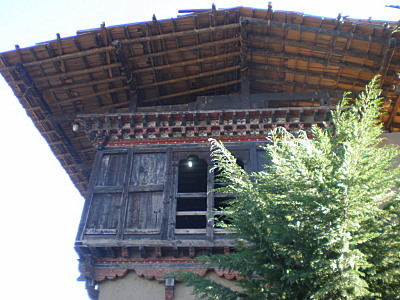

Above - outside and inside of a typical Bhutanese house
In towns, the houses are over shops. These shops all seem to sell the same thing. Sweets, crisps, biscuits and plastic buckets. Note the stray dogs.
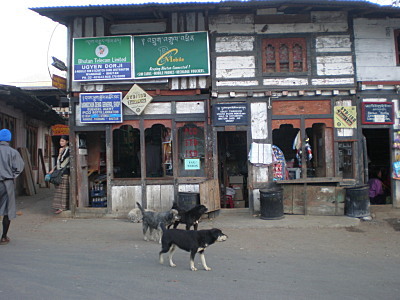
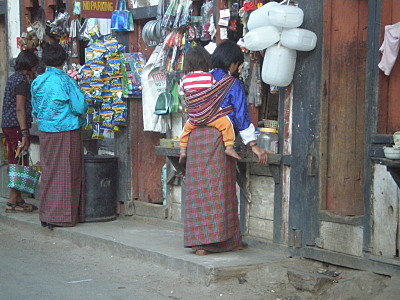
Food is centred on the chilli. The favourite meal is Ema datse, very hot chillis in a cheese sauce. Rice is always served. Pork appears but is only ever strips of fat, no meat. This gives much needed energy in the cold winters. Vegetable don’t feature a lot. Breakfast is – you’ve guessed - chilli with rice. The staple drink is yak butter made into a ‘tea’ with added sugar and salt and hot water – horrible!
Probably the best word to describe Bhutan is ‘adequate’. This describes the one main road that goes East West, the electricity supply, internet and hotels. Although much hydroelectricity is sold to India (Butan’s biggest export), there is insufficient left for Bhutan during the dry season. Many an evening was spent huddled around a candle. The main towns have broadband internet, but we found that the only way to get any usable speed was to use it before 7:30 am. Hotels are good in the main towns but become ‘quaint’ in the villages. Lighting is often by solar panels, hence too dim to read by, and heating in the bedroom via a log burning stove.
The East West road, a series of continuous hairpin bends for 360 km is being widened by cutting into the mountain rock. Bhutanese will happily work the land but prefer to employ Indian road gangs for this job. Little machinery is used, most work being done by bare hands. Women break rocks with hammers and move it in cloth bundles whilst carrying babies on their backs. Meanwhile their small children play in the rubble. The lorries which ply this route create a lot of dust. The workers sleep in huts or tents by the road, before moving to the next stretch. Some life!

Above - Indian Road gang
As a tourist, your day consists of one
of two events: either a visit to a zhong / monastery or a trek. A zhong is the
equivalent to an English castle, although its main purpose now is as government
offices for the district plus a temple. In the past, it would have provided
refuge for all the surrounding villagers in the event of an attack. Treking by
tourists is popular in Bhutan. All the luggage/food/tents is carried by horses
or yaks (if above 4000m) whilst the tourist and guide walk with minimal luggage.
As there is only the one road in Bhutan, visiting villages off this road
involves a trek. The longest official trek is the snowman trek, a 30 day walk
that climbs to around 6000m. This is the one attempted, and failed, by Bruce in
‘Tribe’. We did a 2 day trek, to take in some of the village festivals occurring
in November.
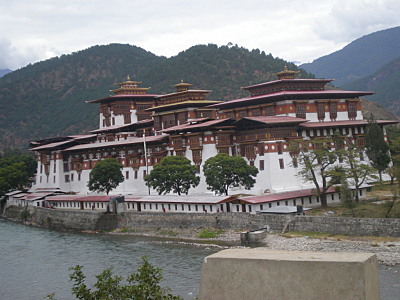
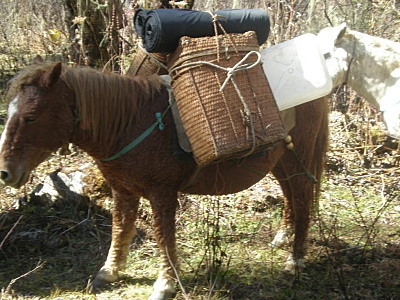
So, should one visit Bhutan? Definitely yes, but come soon before it changes to be just like any other country. A 10 day visit will probably allow most tourist sights to be seen, or add extra days if you want to include a trek. If you do visit, don’t leave home without ear plugs as the numerous cuddly Buddhist stray dogs become howling monsters all night long. Also, don’t expect a treat of local food as all the tourist hotels serve the same bland ‘western’ concoctions. All the tourist chefs have been trained to make the same menu. The lucky guides get to eat real food in the kitchens.
Walking around Bhutan with all the stories of ghosts and demons, we couldn’t help thinking of the Douglas Adams quote: “Isn’t it enough to see that a garden is beautiful without having to believe there are fairies at the bottom of the garden”
